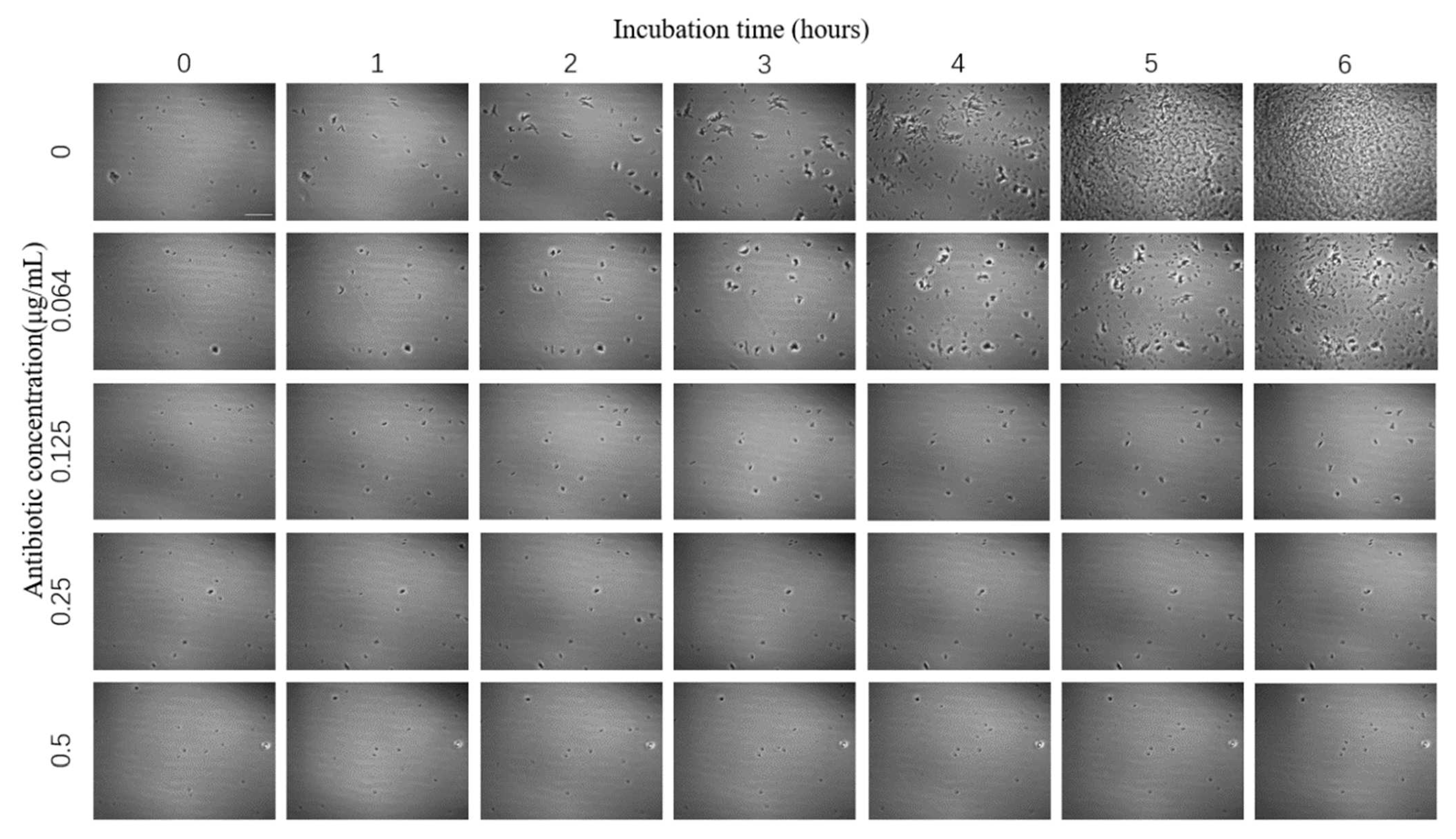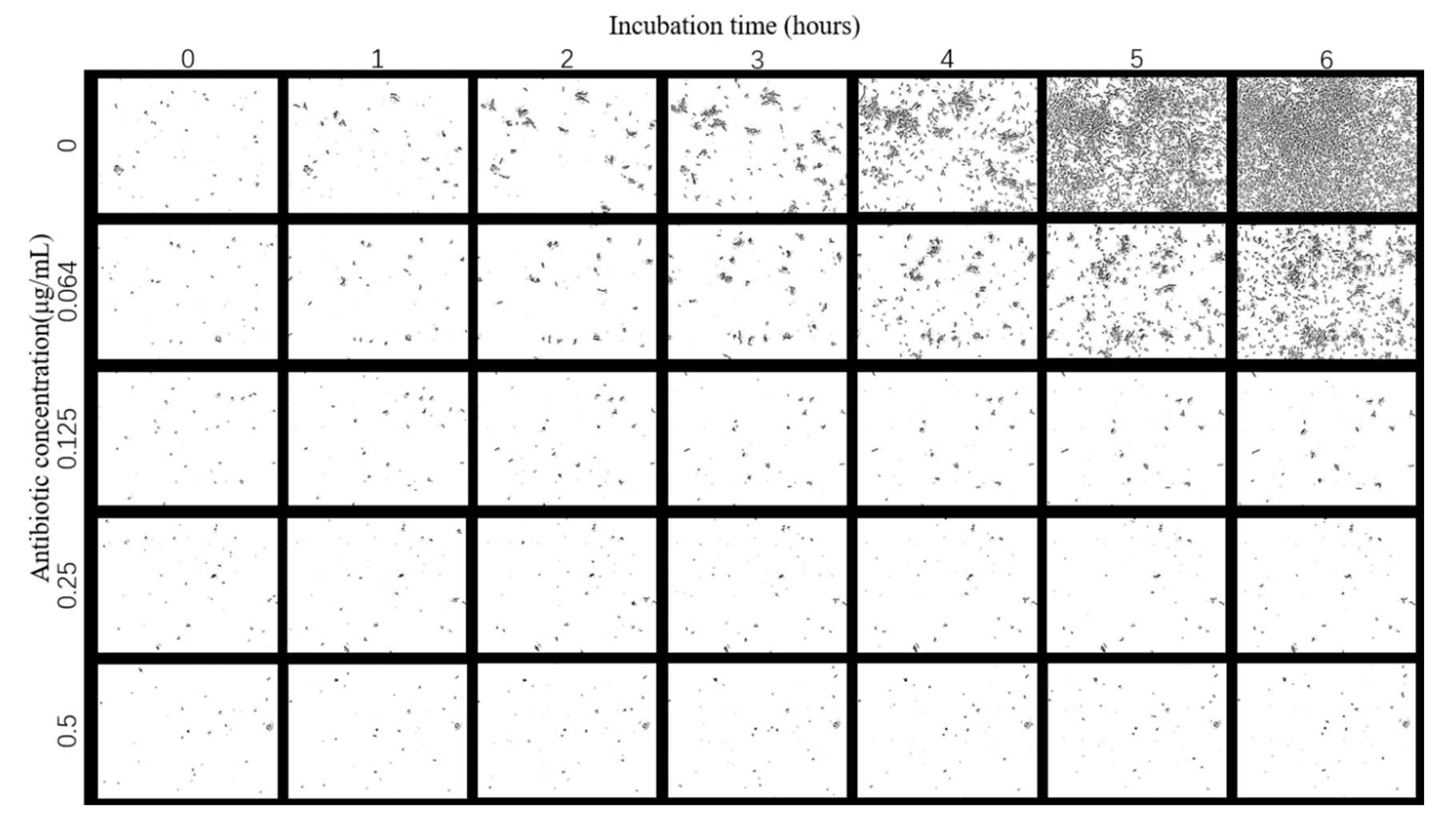Phase Contrast Image-Based Rapid Antimicrobial Susceptibility Testing of Bacteria in Liquid Culture Media
Abstract
:1. Introduction
2. Materials and Methods
2.1. Bacterial Incubation and Sample Preparation
2.2. Centrifugal Device and Centrifugation
2.3. Phase Contrast Microscope
2.4. Image Processing
2.5. AST Using the Broth Microdilution Method
3. Results and Discussion
3.1. Centrifugation
3.2. Images of Bacteria at Different Antibiotic Concentrations
3.3. Image Processing Results
3.4. Change in Bacterial Growth Rate
3.5. Results of the Broth Micro-Dilution Method
3.6. Discussion
4. Conclusions
Supplementary Materials
Author Contributions
Funding
Institutional Review Board Statement
Informed Consent Statement
Data Availability Statement
Conflicts of Interest
References
- Mashalla, Y.; Setlhare, V.; Massele, A.; Sepako, E.; Tiroyakgosi, C.; Kgatlwane, J.; Chuma, M.; Godman, B. Assessment of prescribing practices at the primary healthcare facilities in Botswana with an emphasis on antibiotics: Findings and implications. Int. J. Clin. Pract. 2017, 71, e13042. [Google Scholar] [CrossRef] [PubMed] [Green Version]
- Cassini, A.; Högberg, L.D.; Plachouras, D.; Quattrocchi, A.; Hoxha, A.; Simonsen, G.S.; Colomb-Cotinat, M.; Kretzschmar, M.E.; Devleesschauwer, B.; Cecchini, M.; et al. Attributable deaths and disability-adjusted life-years caused by infections with antibiotic-resistant bacteria in the EU and the European Economic Area in 2015: A population-level modelling analysis. Lancet Infect. Dis. 2019, 19, 56–66. [Google Scholar] [CrossRef] [PubMed] [Green Version]
- Michael, C.A.; Dominey-Howes, D.; Labbate, M. The antimicrobial resistance crisis: Causes, consequences, and management. Front. Public Health 2014, 2, 145. [Google Scholar] [CrossRef] [PubMed]
- Jean, S.S.; Lee, N.Y.; Tang, H.J.; Lu, M.C.; Ko, W.C.; Hsueh, P.R. Carbapenem-Resistant Enterobacteriaceae Infections: Taiwan Aspects. Front. Microbiol. 2018, 9, 2888. [Google Scholar] [CrossRef] [PubMed]
- Behera, B.; Vishnu, A.; Chatterjee, S.; Sitaramgupta, V.S.N.; Sreekumar, N.; Nagabhushan, A.; Rajendran, N.; Prathik, B.H.; Pandya, H.J. Emerging technologies for antibiotic susceptibility testing. Biosens. Bioelectron. 2019, 142, 111552. [Google Scholar] [CrossRef]
- Bauer, K.A.; Perez, K.K.; Forrest, G.N.; Goff, D.A. Review of rapid diagnostic tests used by antimicrobial stewardship programs. Clin. Infect. Dis. 2014, 59 (Suppl. S3), 134–145. [Google Scholar] [CrossRef]
- Zhou, H.; Shi, L.M.; Li, G.X.; Zhang, Z.J.; Shi, W.F. Advances in the study of the detection of carbapenem-resistant Enterobacteriaceae and antibacterial strategies. J. Pathog. Biol. 2018, 13, 432–435+439. [Google Scholar]
- Wiegand, I.; Hilpert, K.; Hancock, R. Agar and broth dilution methods to determine the minimal inhibitory concentration (MIC) of antimicrobial substances. Nat. Protoc. 2008, 3, 163–175. [Google Scholar] [CrossRef]
- Zernike, F. How I discovered phase contrast. Science 1955, 121, 345–349. [Google Scholar] [CrossRef]
- Kasprowicz, R.; Suman, R.; O’Toole, P. Characterising live cell behaviour: Traditional label-free and quantitative phase imaging approaches. Int. J. Biochem. Cell Biol. 2017, 84, 89–95. [Google Scholar] [CrossRef]
- McGoverin, C.; Steed, C.; Esan, A.; Robertson, J.; Swift, S.; Vanholsbeeck, F. Optical methods for bacterial detection and characterization. APL Photonics 2021, 6, 080903. [Google Scholar] [CrossRef]
- Chen, C.; Hong, W.L. Recent Development of Rapid Antimicrobial Susceptibility Testing Methods through Metabolic Profiling of Bacteria. Antibiotics 2021, 10, 311. [Google Scholar] [CrossRef]
- Song, D.H.; Lei, Y. Mini-review: Recent advances in imaging-based rapid antibiotic susceptibility testing. Sens. Actuators Rep. 2021, 3, 100053. [Google Scholar] [CrossRef]
- Song, D.H.; Liu, H.M.; Dong, Q.C.; Bian, Z.C.; Wu, H.X.; Lei, Y. Digital, Rapid, Accurate, and Label-Free Enumeration of Viable Microorganisms Enabled by Custom-Built On-Glass-Slide Culturing Device and Microscopic Scanning. Sensors 2018, 18, 3700. [Google Scholar] [CrossRef] [Green Version]
- Song, D.H.; Liu, H.M.; Ji, H.Y.; Lei, Y. Whole Slide Imaging for High-Throughput Sensing Antibiotic Resistance at Single-Bacterium Level and Its Application to Rapid Antibiotic Susceptibility Testing. Molecules 2019, 24, 2441. [Google Scholar] [CrossRef] [Green Version]
- Choi, J.; Jung, Y.G.; Kim, J.; Kim, S.; Jung, Y.; Na, H.; Kwon, S. Rapid antibiotic susceptibility testing by tracking single cell growth in a microfluidic agarose channel system. Lab Chip 2013, 13, 280–287. [Google Scholar] [CrossRef]
- Choi, J.; Yoo, J.; Lee, M.; Kim, E.G.; Lee, J.S.; Lee, S.; Joo, S.; Song, S.H.; Kim, E.C.; Lee, J.C.; et al. A rapid antimicrobial susceptibility test based on single-cell morphological analysis. Sci. Transl. Med. 2014, 6, 267ra174. [Google Scholar] [CrossRef]
- Choi, J.; Jeong, H.Y.; Lee, G.Y.; Han, S.; Han, S.; Jin, B.; Lim, T.; Kim, S.; Kim, D.Y.; Kim, H.C.; et al. Direct, rapid antimicrobial susceptibility test from positive blood cultures based on microscopic imaging analysis. Sci. Rep. 2017, 7, 1148. [Google Scholar] [CrossRef] [Green Version]
- Kang, W.J.; Sarkar, S.; Lin, Z.S.; McKenney, S.; Konry, T. Ultrafast Parallelized Microfluidic Platform for Antimicrobial Susceptibility Testing of Gram Positive and Negative Bacteria. Anal. Chem. 2019, 91, 6242–6249. [Google Scholar] [CrossRef]
- Baltekin, O.; Boucharin, A.; Tano, E.; Andersson, D.I.; Elf, J. Antibiotic susceptibility testing in less than 30 min using direct single-cell imaging. Proc. Natl. Acad. Sci. USA 2017, 114, 9170–9175. [Google Scholar] [CrossRef] [Green Version]
- Li, H.; Torab, P.; Mach, K.E.; Surrette, C.; England, M.R.; Craft, D.W.; Thomas, N.J.; Liao, J.C.; Puleo, C.; Wong, P.K. Adaptable microfluidic system for single-cell pathogen classification and antimicrobial susceptibility testing. Proc. Natl. Acad. Sci. USA 2019, 116, 10270–10279. [Google Scholar] [CrossRef] [PubMed]
- Weeks, O.B.; Beck, S.M. Removal of bacterial cells from liquid media using a foerst continuous-type centrifuge. J. Bacteriol. 1956, 71, 127–128. [Google Scholar] [CrossRef] [PubMed]







Disclaimer/Publisher’s Note: The statements, opinions and data contained in all publications are solely those of the individual author(s) and contributor(s) and not of MDPI and/or the editor(s). MDPI and/or the editor(s) disclaim responsibility for any injury to people or property resulting from any ideas, methods, instructions or products referred to in the content. |
© 2022 by the authors. Licensee MDPI, Basel, Switzerland. This article is an open access article distributed under the terms and conditions of the Creative Commons Attribution (CC BY) license (https://creativecommons.org/licenses/by/4.0/).
Share and Cite
Zhang, X.; Wang, X.; Bao, Y.; Shen, Z.; Xu, Y.; Wang, B.; Zhang, H.; Guan, T.; He, Y. Phase Contrast Image-Based Rapid Antimicrobial Susceptibility Testing of Bacteria in Liquid Culture Media. Sensors 2023, 23, 59. https://doi.org/10.3390/s23010059
Zhang X, Wang X, Bao Y, Shen Z, Xu Y, Wang B, Zhang H, Guan T, He Y. Phase Contrast Image-Based Rapid Antimicrobial Susceptibility Testing of Bacteria in Liquid Culture Media. Sensors. 2023; 23(1):59. https://doi.org/10.3390/s23010059
Chicago/Turabian StyleZhang, Xiaonan, Xuenian Wang, Yaqing Bao, Zhiyuan Shen, Yang Xu, Bei Wang, Haowei Zhang, Tian Guan, and Yonghong He. 2023. "Phase Contrast Image-Based Rapid Antimicrobial Susceptibility Testing of Bacteria in Liquid Culture Media" Sensors 23, no. 1: 59. https://doi.org/10.3390/s23010059
APA StyleZhang, X., Wang, X., Bao, Y., Shen, Z., Xu, Y., Wang, B., Zhang, H., Guan, T., & He, Y. (2023). Phase Contrast Image-Based Rapid Antimicrobial Susceptibility Testing of Bacteria in Liquid Culture Media. Sensors, 23(1), 59. https://doi.org/10.3390/s23010059




